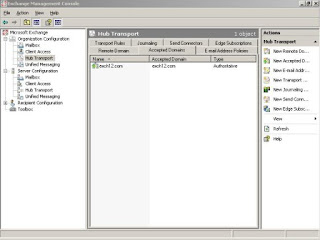
Assuming that your Exchange 2007 server contains the Hub Transport role, you will need to define at least one accepted domain for the Exchange Server organization. An accepted domain is any domain namespace for which the Exchange server can send and receive SMTP email. In most cases, the Exchange server is considered to be authoritative for accepted domains, but accepted domains can include both authoritative domains and relay domains.
By default, the fully qualified domain name (FQDN) of your forest's root domain is defined as an accepted domain for the Exchange Server organization. Having this default-accepted domain entry will make it possible to send email back and forth locally. But in the real world, you probably want to define other authoritative domains for your organization, such as external SMTP domains.
To define the Exchange Server 2007 organization's accepted domains, navigate through the console tree to Microsoft Exchange -> Organization Configuration -> Hub Transport.
When you select the Hub Transport container, the console's details pane will display the hub transport's properties sheet. Select the Accepted Domains tab. As you can see in Figure 9, the local domain name should already be listed.
By default, the fully qualified domain name (FQDN) of your forest's root domain is defined as an accepted domain for the Exchange Server organization. Having this default-accepted domain entry will make it possible to send email back and forth locally. But in the real world, you probably want to define other authoritative domains for your organization, such as external SMTP domains.
To define the Exchange Server 2007 organization's accepted domains, navigate through the console tree to Microsoft Exchange -> Organization Configuration -> Hub Transport.
When you select the Hub Transport container, the console's details pane will display the hub transport's properties sheet. Select the Accepted Domains tab. As you can see in Figure 9, the local domain name should already be listed.